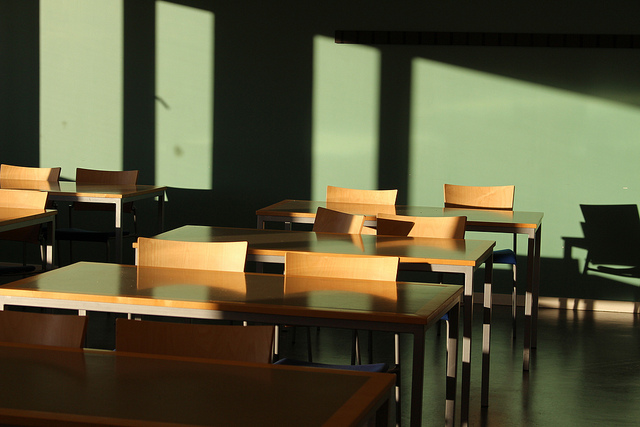New measures to counter radicalisation in Australian schools
Posted By Anthony Bergin on February 19, 2016 @ 11:00
In recent times we’ve seen young Australians commit acts of violent extremism [2] on home soil.
The Turnbull government recently announced [3] it was introducing further measures give educators and parents more help to support school-aged youth at risk of radicalisation. In December last year the Council of Australian Governments also made a commitment [4] to better resource schools and students to tackle this issue.
The new schools measures [5] will provide classroom resources to build students’ resilience to violent extremist influences; awareness training for school staff on understanding radicalisation and student referral opportunities; and develop mechanisms for school communities and parents to receive and share information. A series of local community youth forums will provide young people with the opportunity to explore the problem.
These welcome new measures are important because schools play a crucial role in developing our young people and fostering their sense of inclusion in the Australian community—a key bulwark against radicalisation.
Teachers are in a position to notice behavioural changes in students, and enhance the effectiveness of counter radicalisation messaging. Where a student’s behaviour indicates they’re beyond the capabilities of a school’s support system, then teachers will need to be able to refer cases to trained professionals for intervention.
It makes sense to build awareness about radicalisation and extremism amongst school teachers who have regular contact with young people. That means providing them with useful information about how to recognise and respond to radicalisation. Better equipping teachers here will assist parents to raise and discuss their concerns with their children’s schools.
Last year a federal government radicalisation awareness kit provided useful basic information [6] to schools about the early warning signs of radicalisation and how to help students at risk.
The kit was widely lampooned on social media [7] because it linked green activism and alternative music to terrorism, but it isn’t a bad resource to assist schools in understanding radicalisation and how it could affect students.
It’s also useful that the government has recognised that efforts must go beyond providing factual information.
Teachers are certainly going to have to be trained in recognising early warning signs and ways in which they can reach out to at-risk youth, just as they do now with drug and alcohol abuse, the dangers of paedophilia or mental health.
As noted above, teachers will also need opportunities to discuss concerns with trained professionals across social services, health, and child protection agencies, and be empowered to refer those cases that need more formal management. New South Wales has already established a phone line for teachers [8] to access this kind of expertise.
It’s also useful that the government is working to counter online radicalisation of young people by working with social media companies [9] to take down extremist material. Such public–private collaboration to combat radicalisation is increasingly happening around the world.
One further step that should be taken as part of the government’s efforts to safeguard young people from violent extremism is to introduce more comprehensive study about different religions to help students distinguish between religion and ideology.
This doesn’t happen now. The Victorian government, for example, has placed special religious instruction in government schools [10] outside class time to during lunchtime and after school which in effect, results in scrapping them.
For this to be effective, however, we’d need appropriate support for teachers to ensure they have a solid understanding of different religions: many teachers currently don’t have sufficient training to instruct on the world’s major religions. Very few universities in Australia have studies in religion programs. Representatives from a range of faiths could be involved in teaching on comparative religion. The best place for including religious and secular worldviews in the general school curriculum is in terms of cultural diversity and through looking at religious diversity as an example.
A common objection to more comprehensive teaching about religion in Australian schools is that Australia is a secular society and so teaching religion in schools simply isn’t appropriate.
But the word ‘secular’ means different things to different people: from a benign understanding of the concept of the separation of religion and the state to anti-religious dogmatism. The important historical separation of Church and State concerns matters of governance: the Church should not run the State, and the State should not run the Church.
It’s better in this context to talk not about Australia as a secular society, but as a civil society where there is freedom of religion and separation of religion and state. Australia’s future is as a multi-faith nation as opposed to a secular nation.
Education ministries speak about secular education because of the mantra ‘free, secular and compulsory’ but I’d suggest that teaching comparative religion should be just a normal part of the school curriculum. The model of separation we follow in Australia is a fairly moderate model, unlike the French (laïcité) approach [11].
The general point, however, is that knowledge about, and respectful encounter with, religion may reduce the risks [12] that our young people will be caught up in the web of violent extremism.
Article printed from The Strategist: https://www.aspistrategist.org.au
URL to article: https://www.aspistrategist.org.au/new-measures-to-counter-radicalisation-in-australian-schools/
URLs in this post:
[1] Image: http://www.aspistrategist.org.au/wp-content/uploads/2016/02/11042066023_e222ec5f8f_z.jpg
[2] commit acts of violent extremism: https://www.aspi.org.au/publications/gen-y-jihadists-preventing-radicalisation-in-australia
[3] announced: https://www.ministerjustice.gov.au/Mediareleases/Pages/2016/FirstQuarter/6-February-2016-New-initiatives-in-schools-to-safeguard-our-youth.aspx
[4] commitment: https://www.coag.gov.au/node/529#4
[5] new schools measures: https://www.coag.gov.au/node/529%234
[6] provided useful basic information: https://www.livingsafetogether.gov.au/informationadvice/Documents/preventing-violent-extremism-and-radicalisation-in-australia.pdf
[7] lampooned on social media: http://www.abc.net.au/news/2015-09-24/anti-radicalisation-kit-under-fire-from-green-groups-teachers/6803024
[8] established a phone line for teachers: http://www.smh.com.au/nsw/premier-mike-bairds-47-million-package-to-fight-violent-extremist-in-schools-20151102-gkolip.html
[9] working with social media companies: http://www.news.com.au/national/politics/counter-terrorism-experts-meet-in-canberra-led-by-prime-minister-malcolm-turnbull-to-fight-extremism/news-story/5d681c5e111bffa97ab1e899504aa25c
[10] special religious instruction in government schools: http://www.theage.com.au/victoria/religious-instruction-scrapped-from-curriculum-20150820-gj425e.html
[11] French (laïcité) approach: https://theconversation.com/the-french-myth-of-secularism-36227
[12] reduce the risks: http://www.theage.com.au/comment/religious-study-in-schools-can-play-a-vital-role-in-countering-violent-extremism-20151118-gl1tb0.html
Click here to print.
